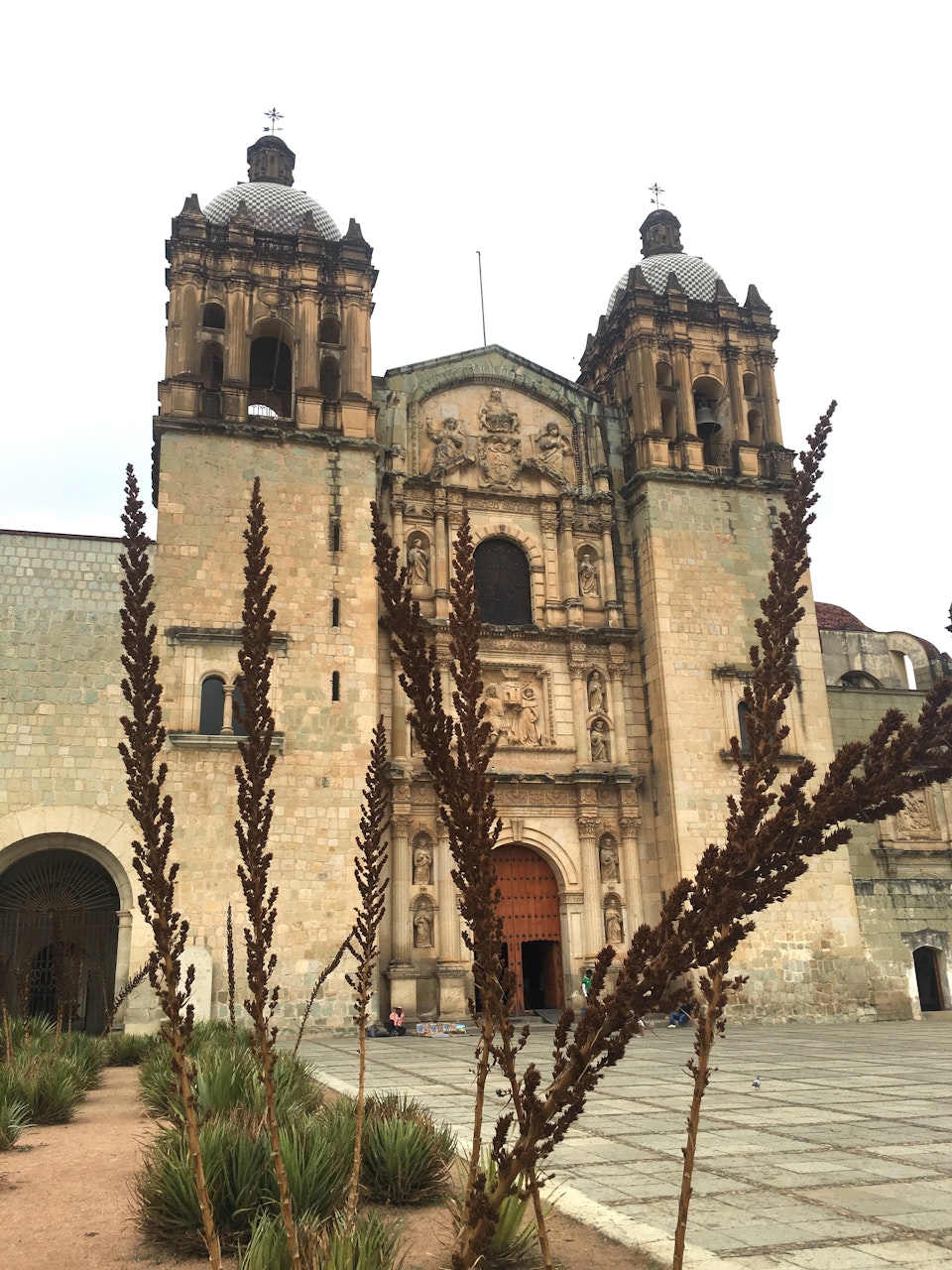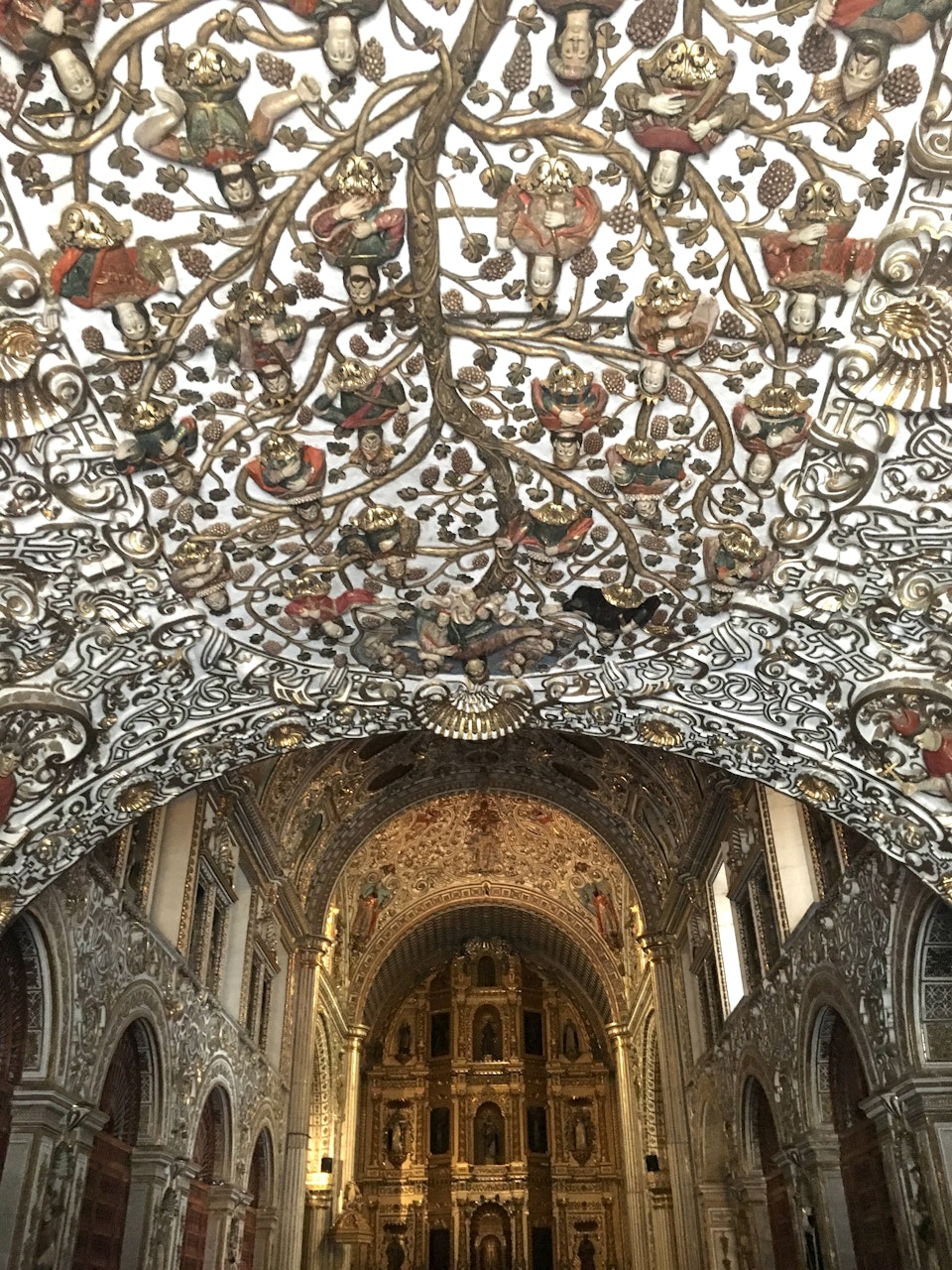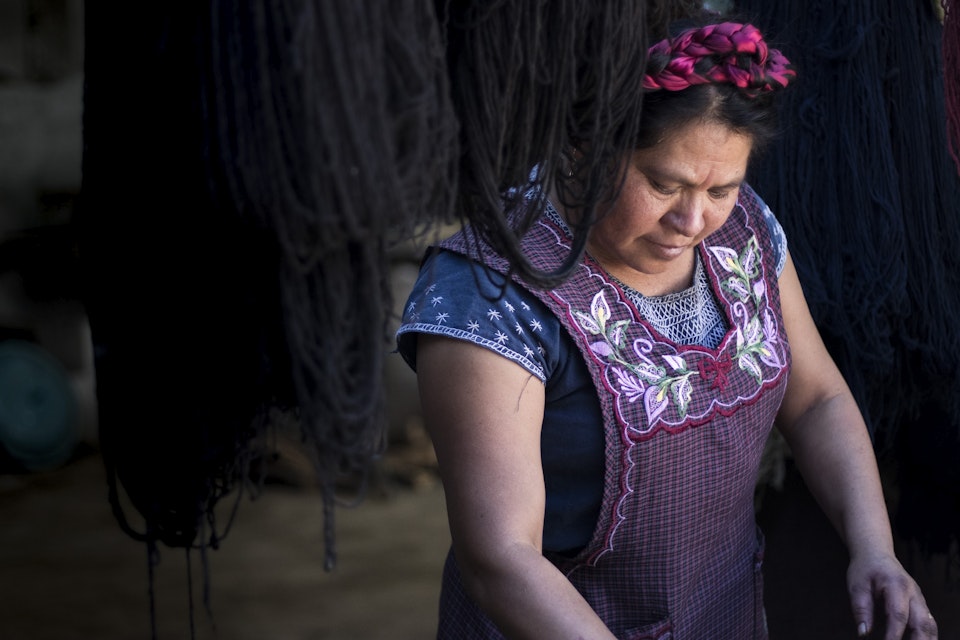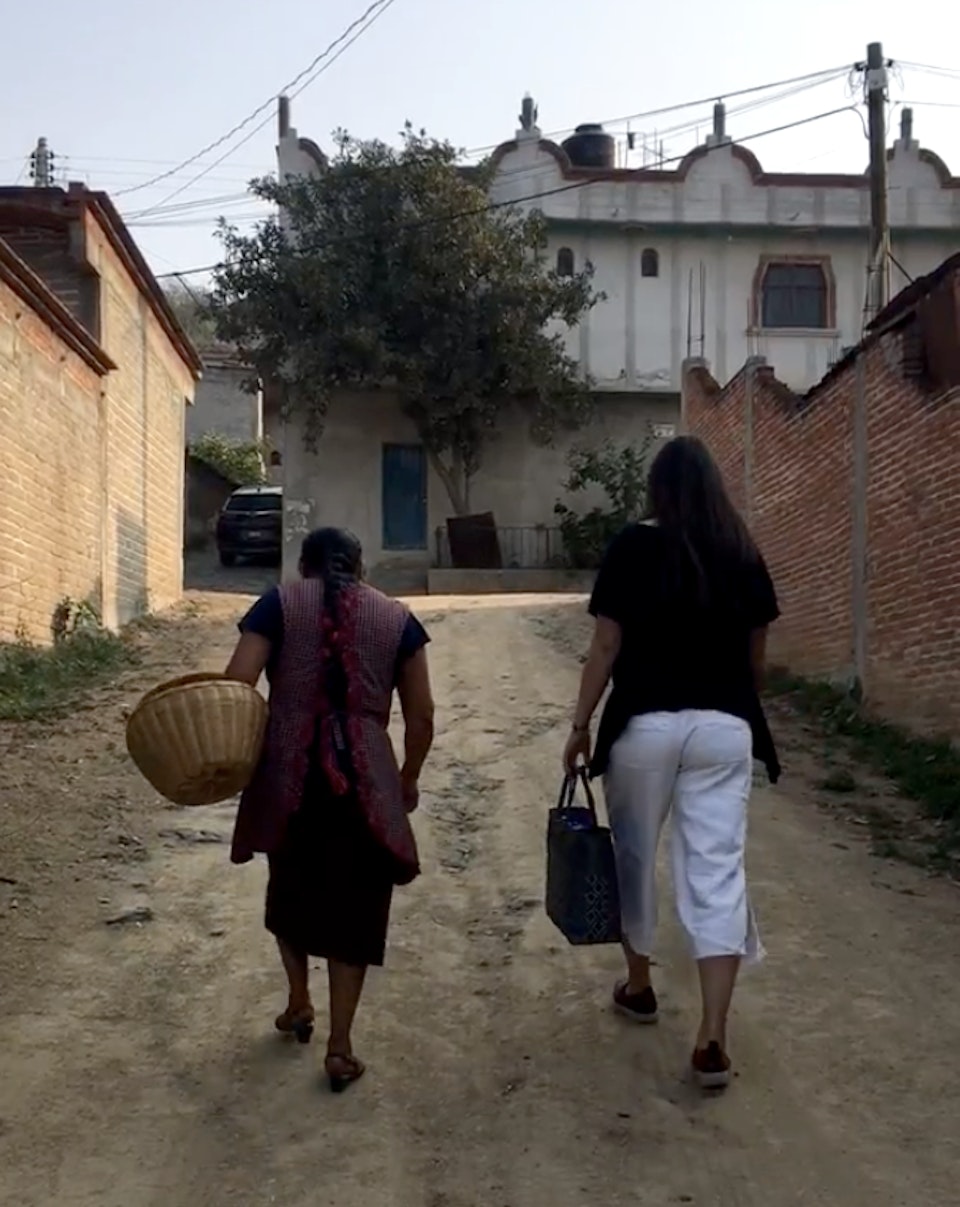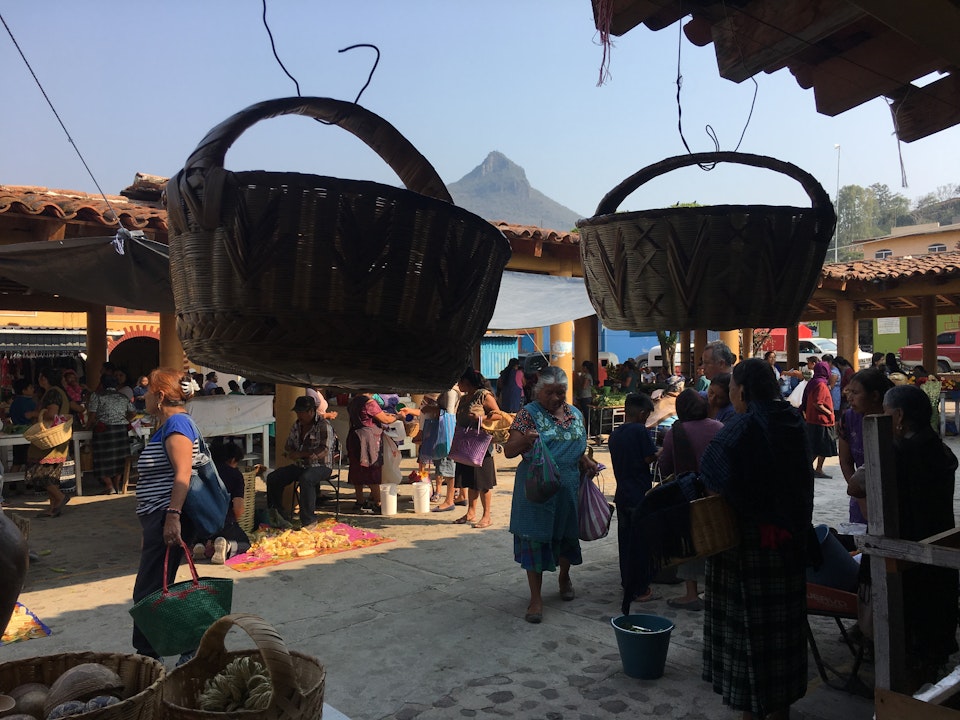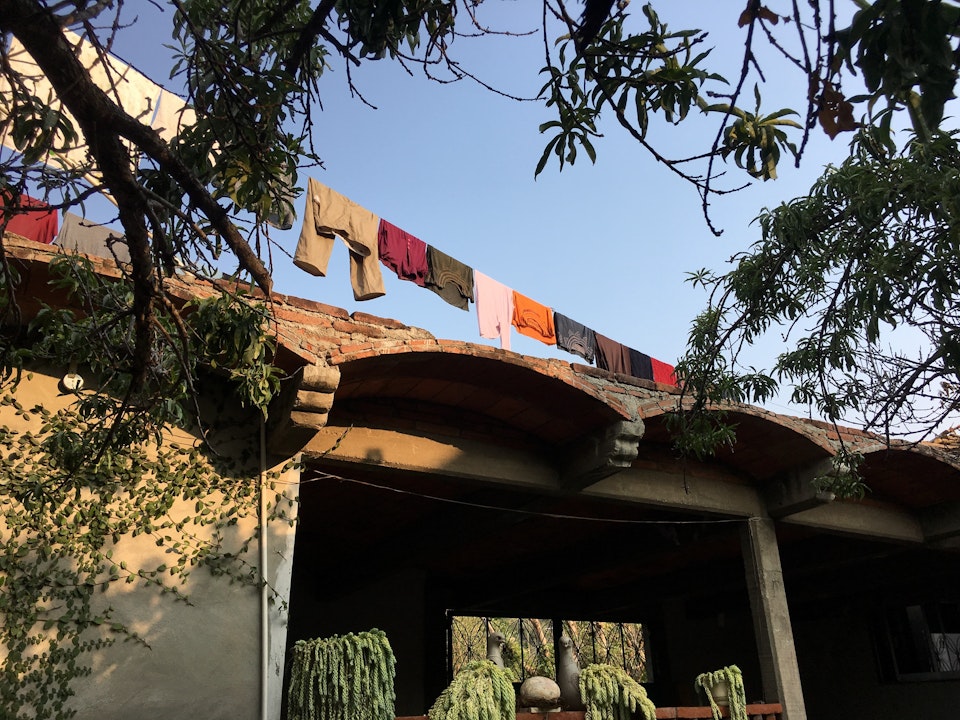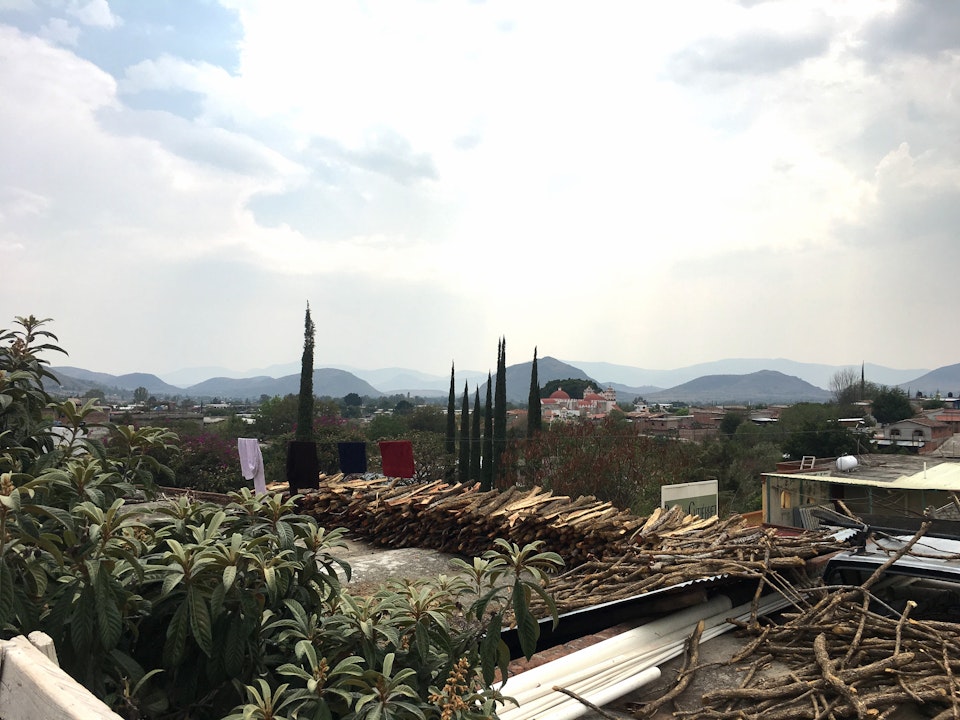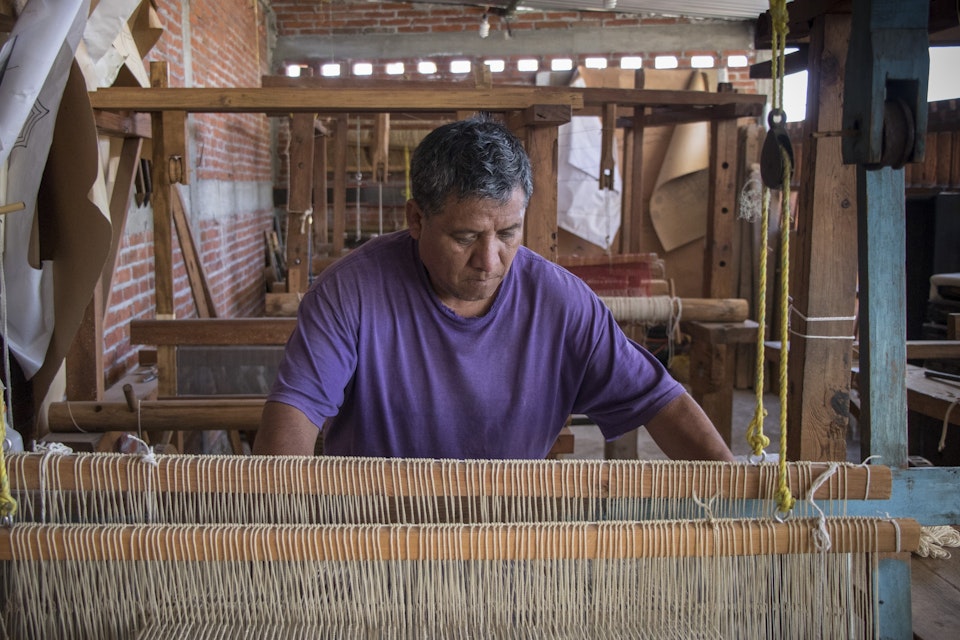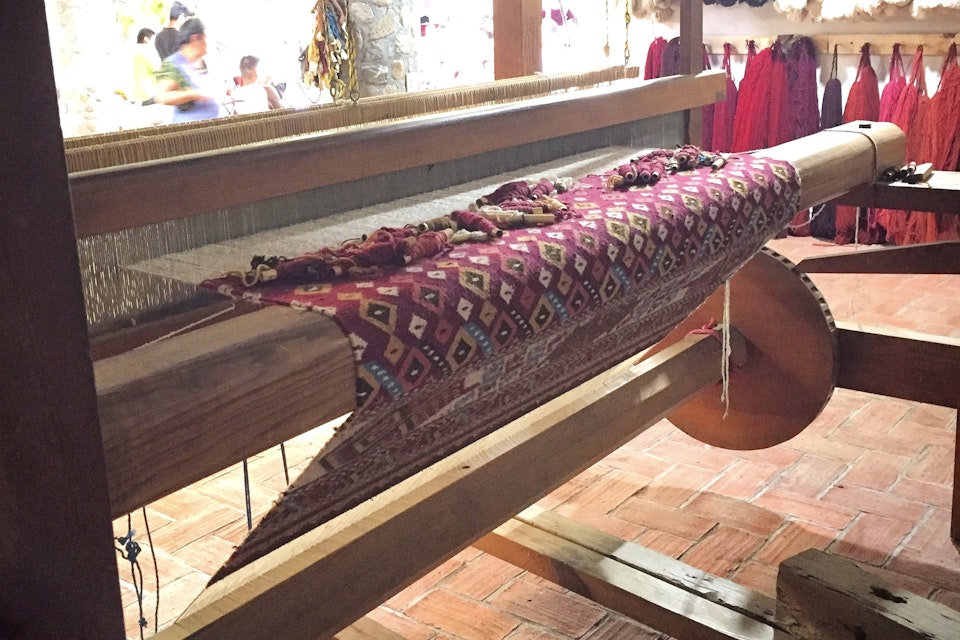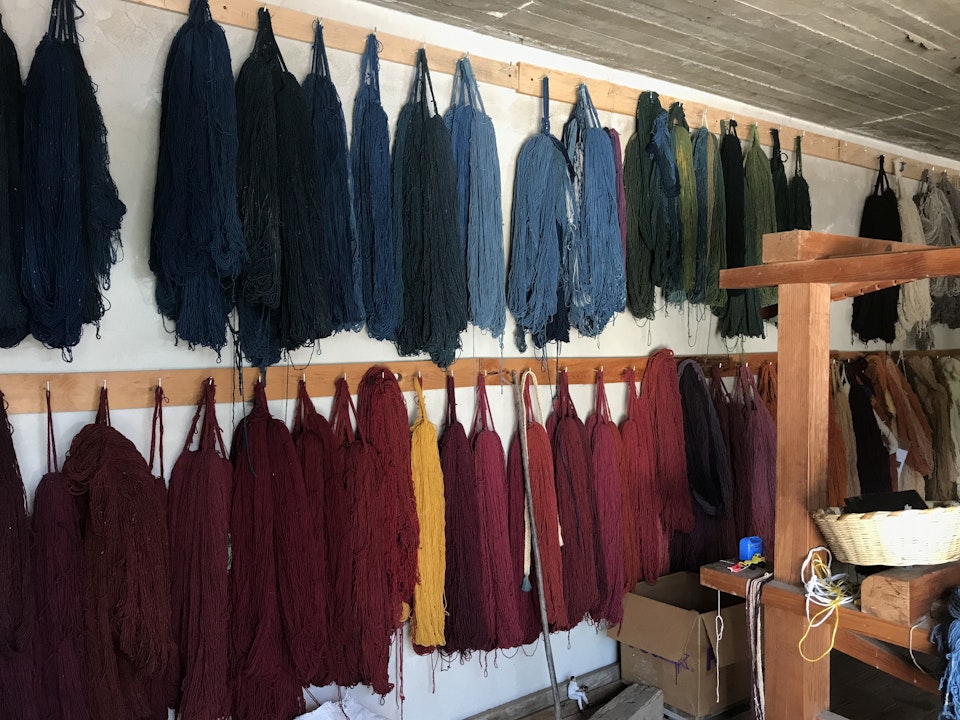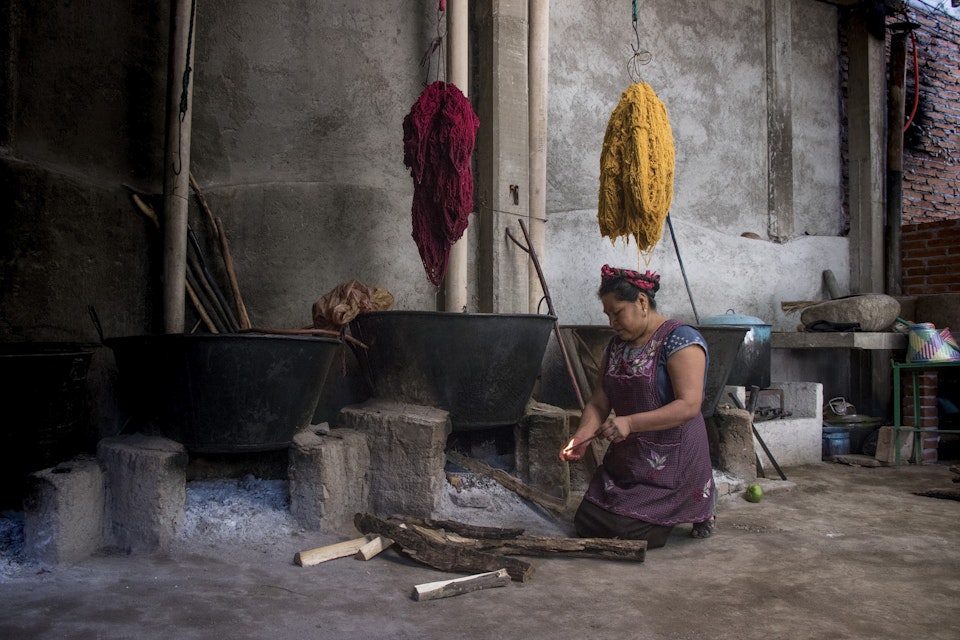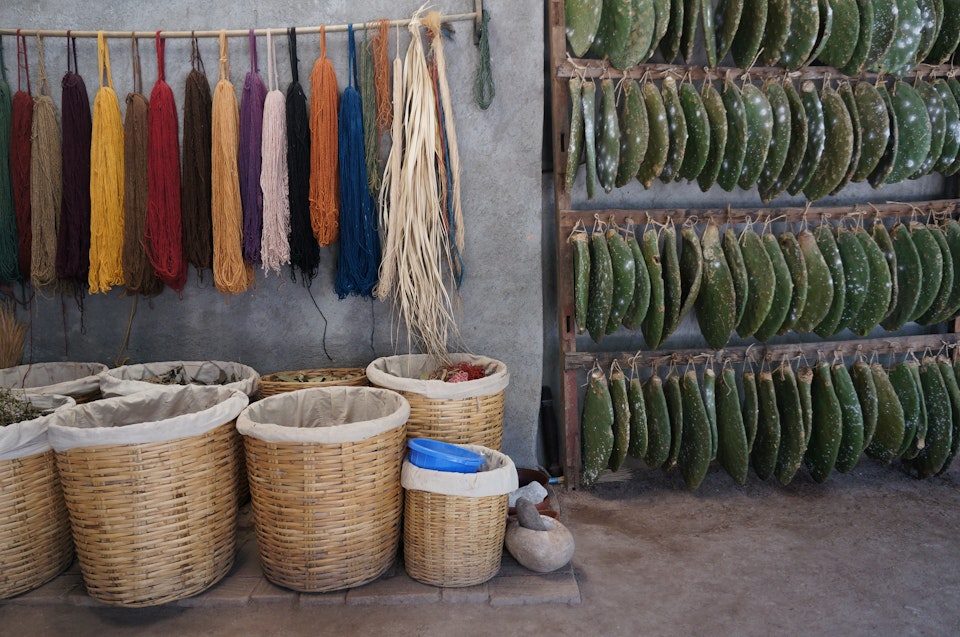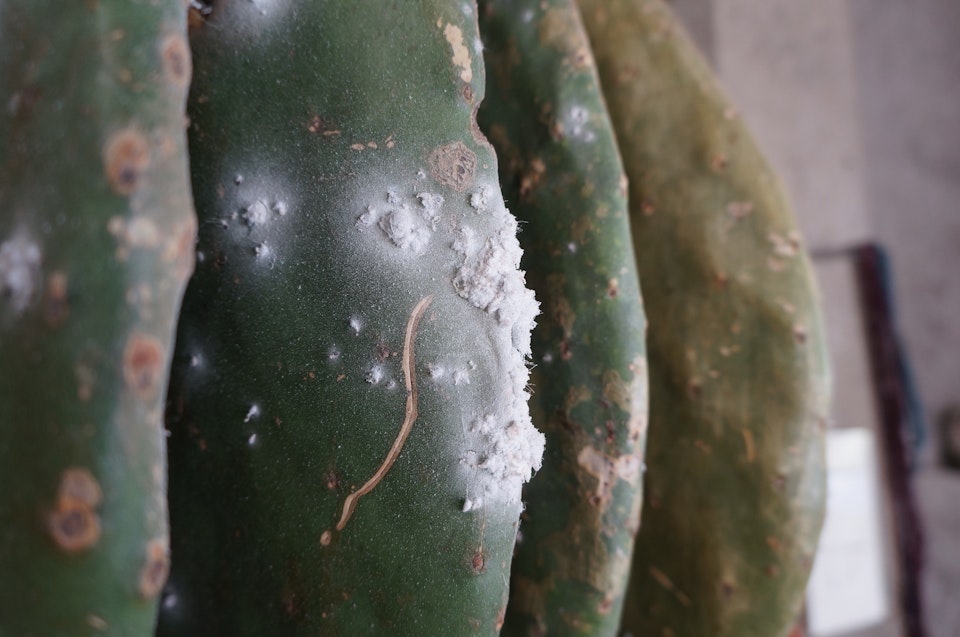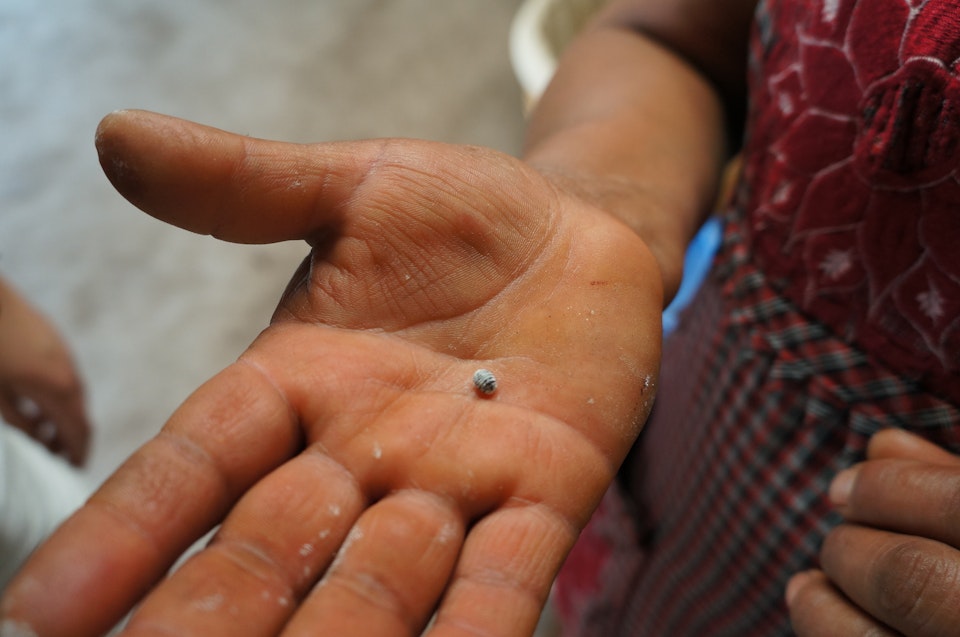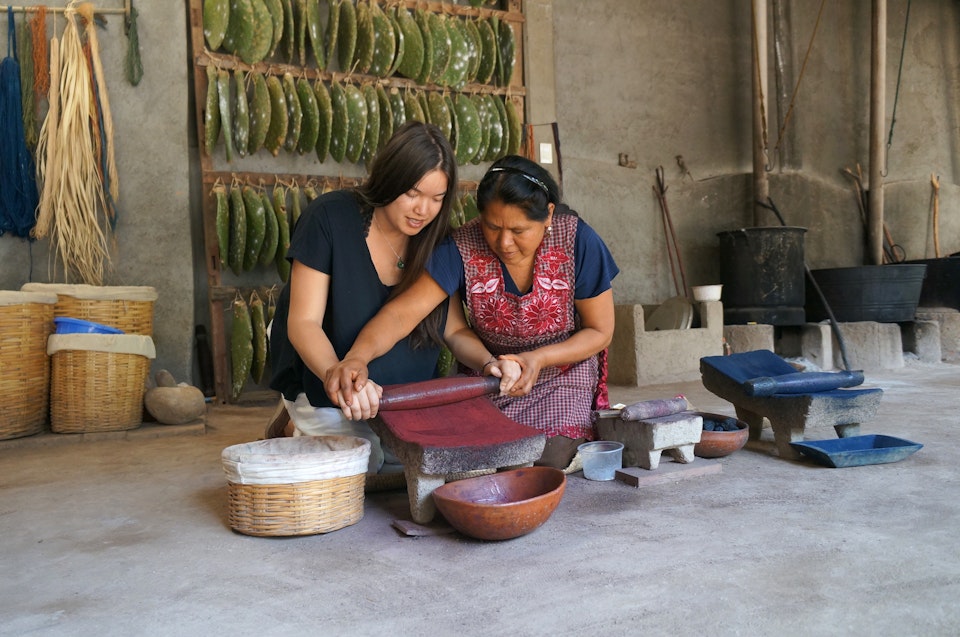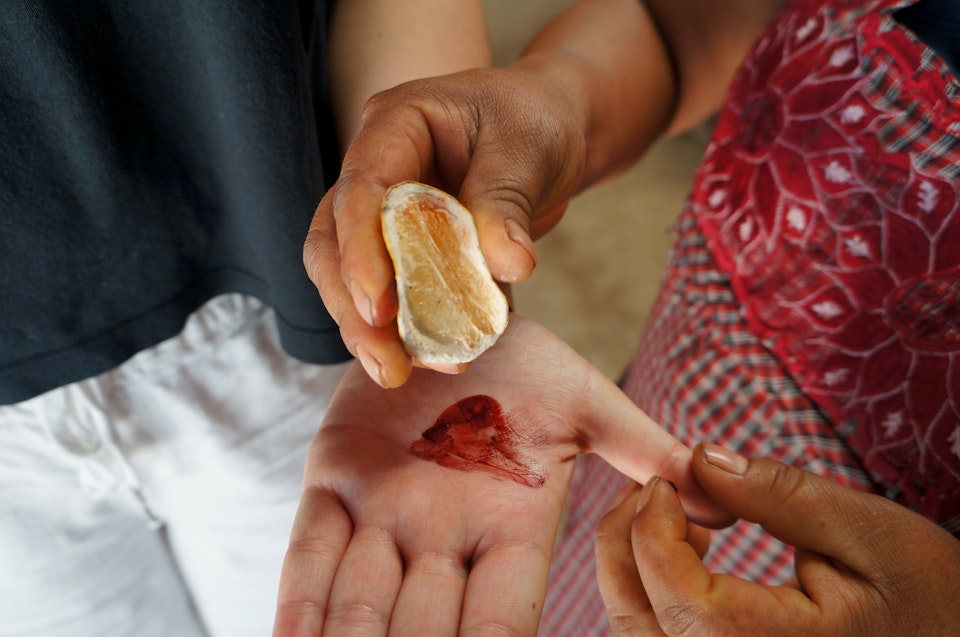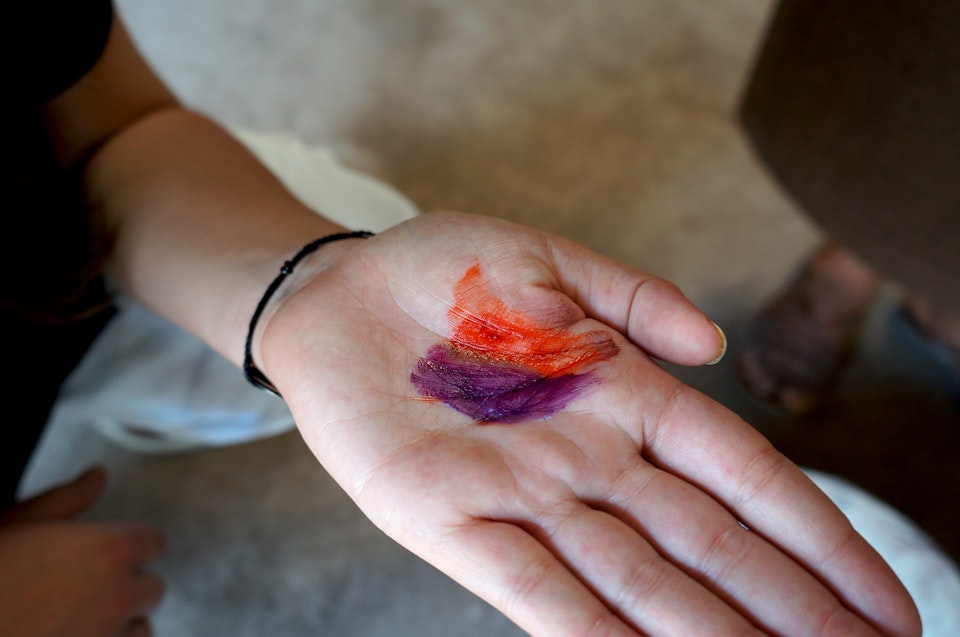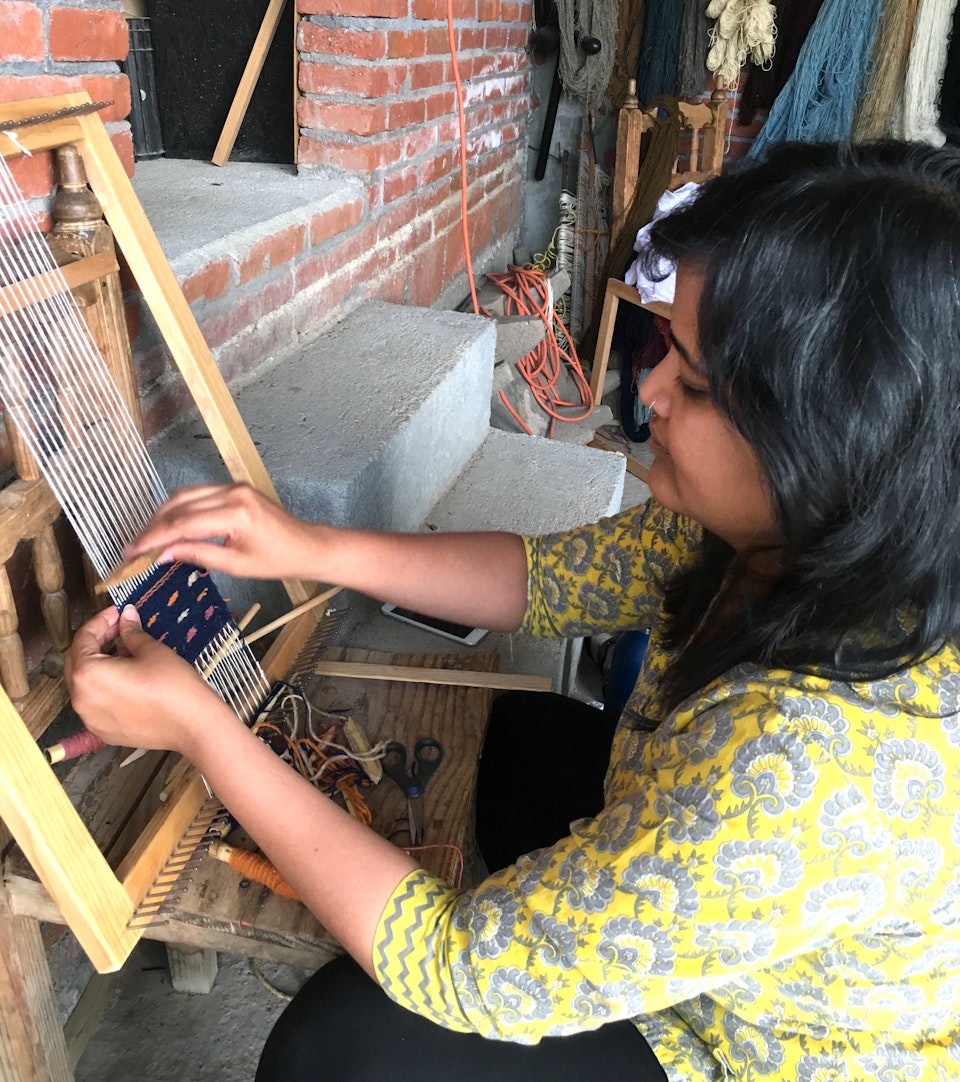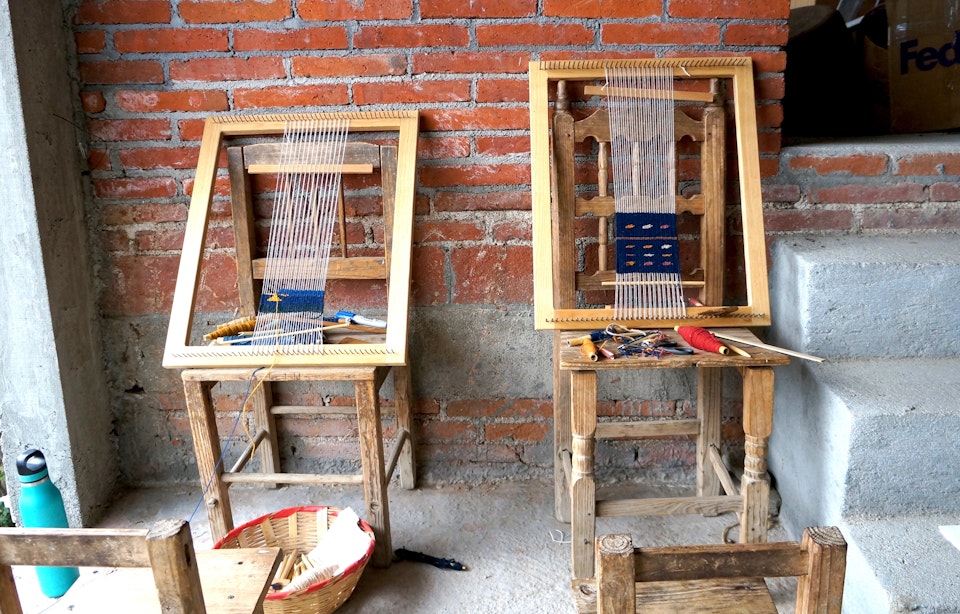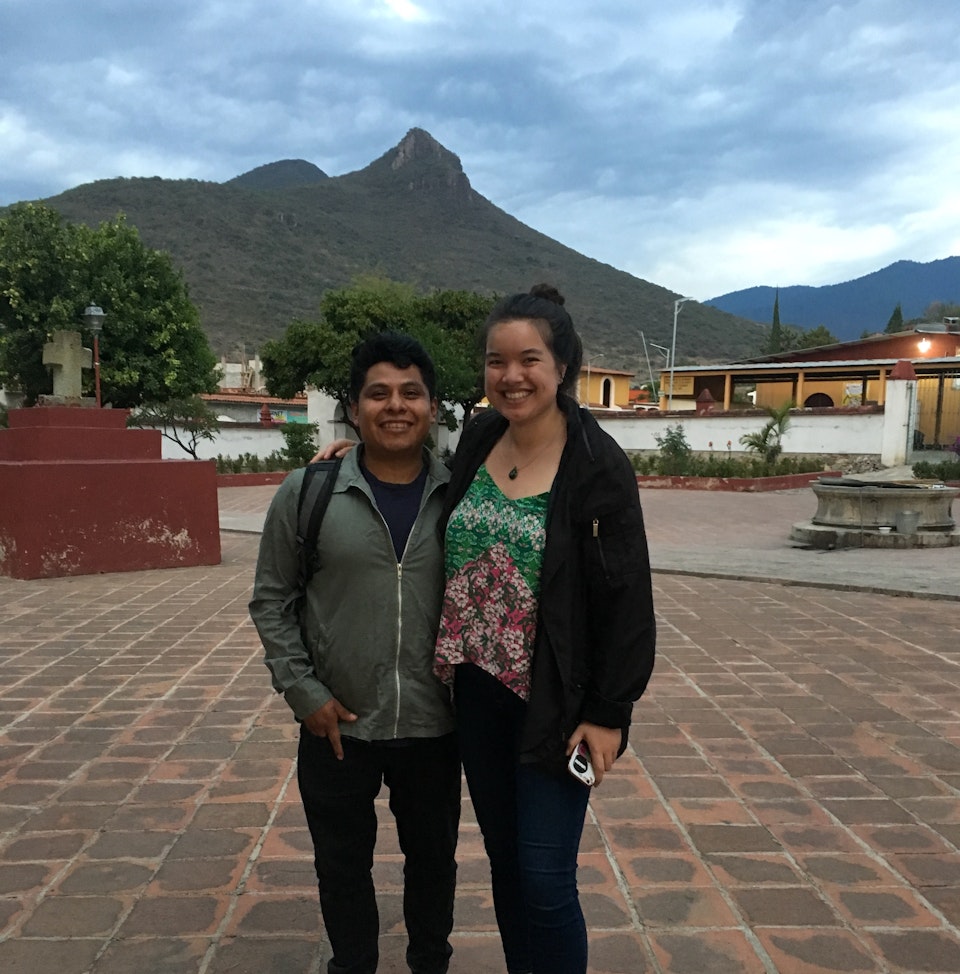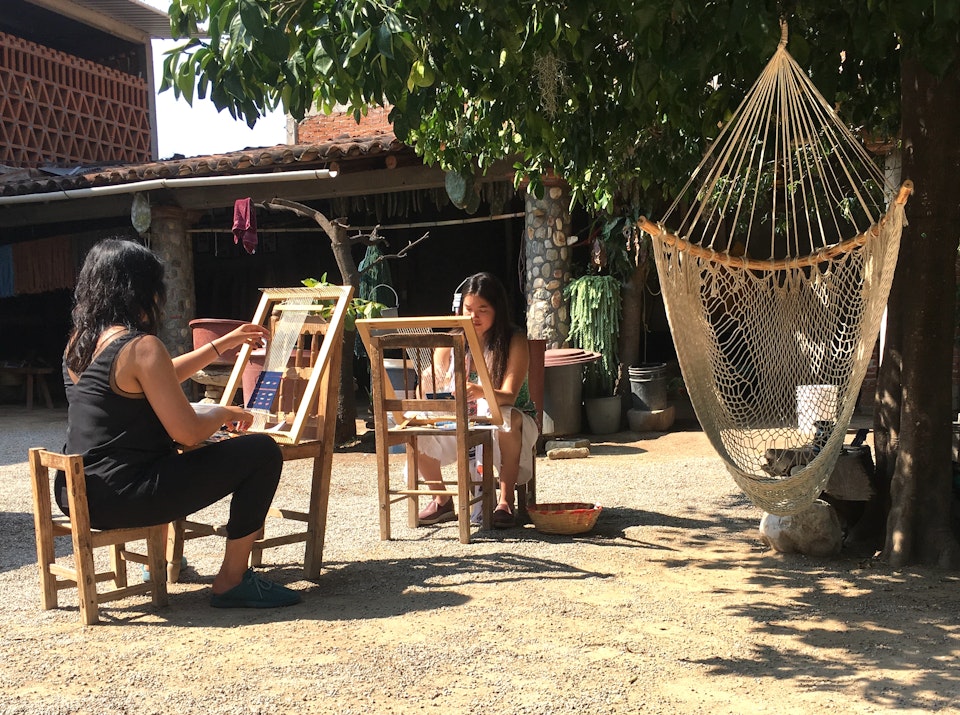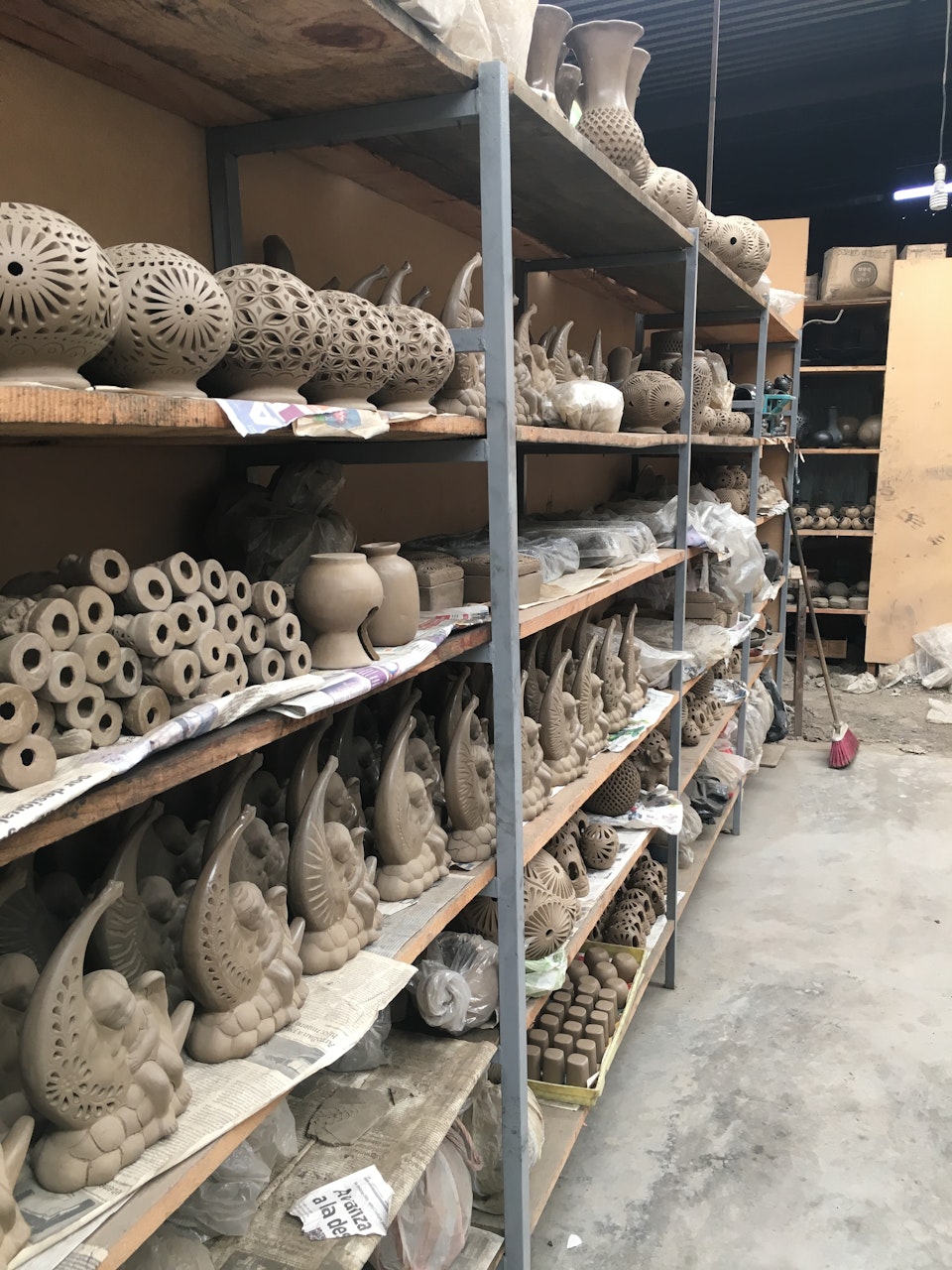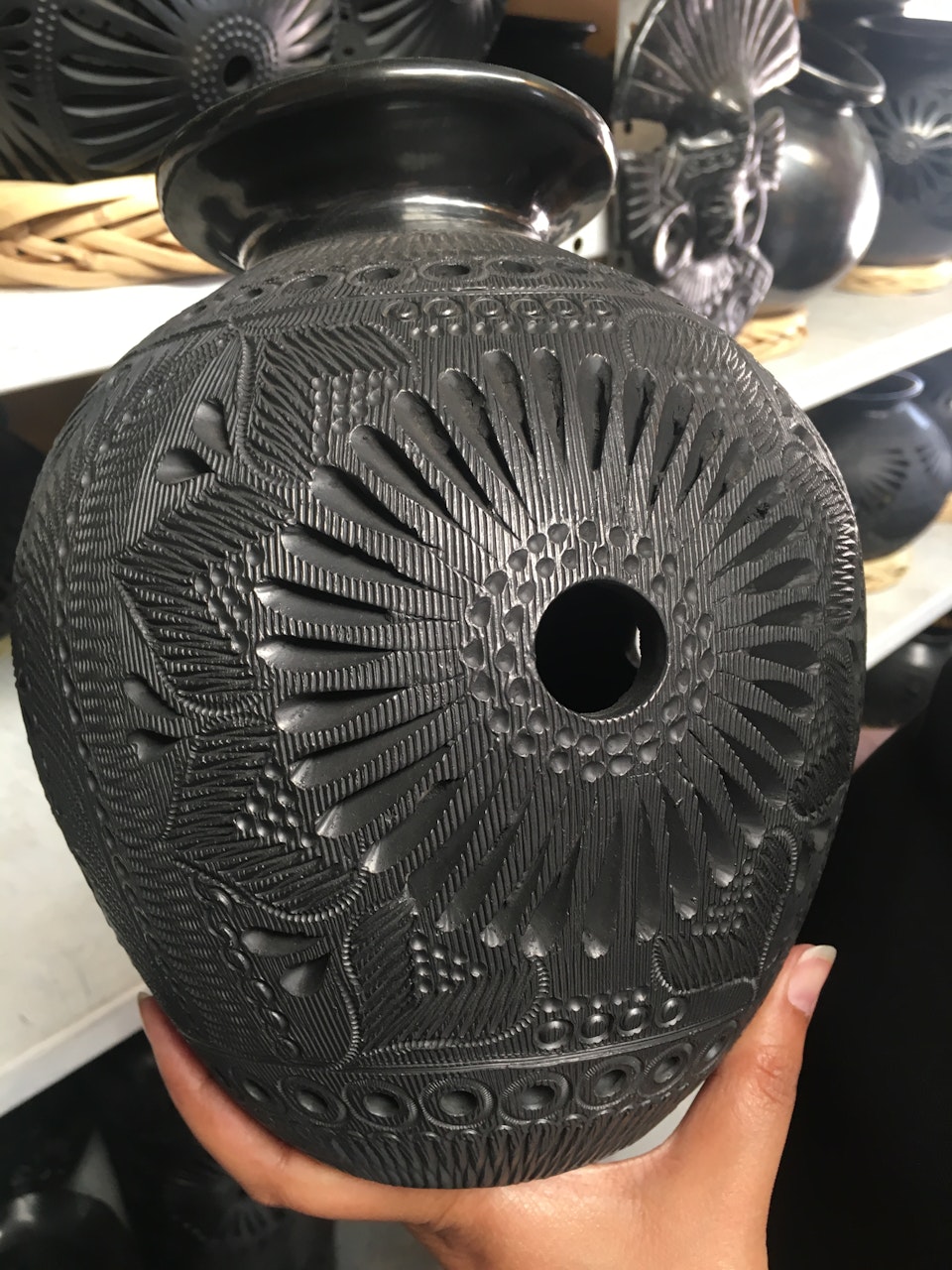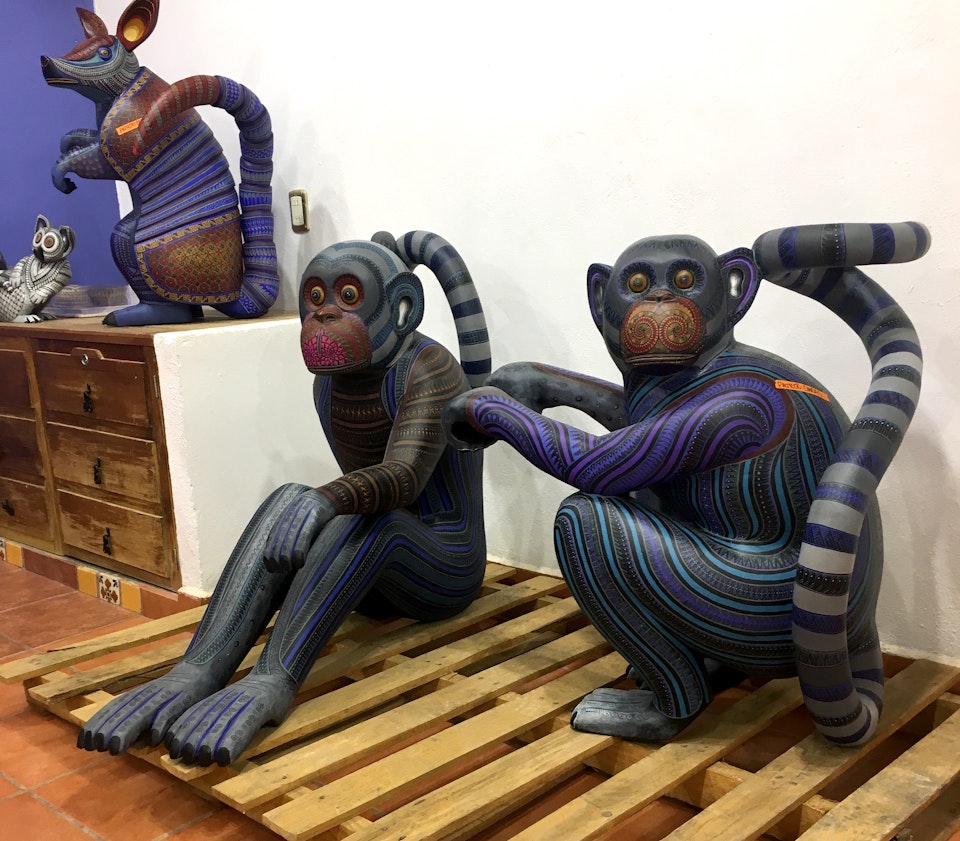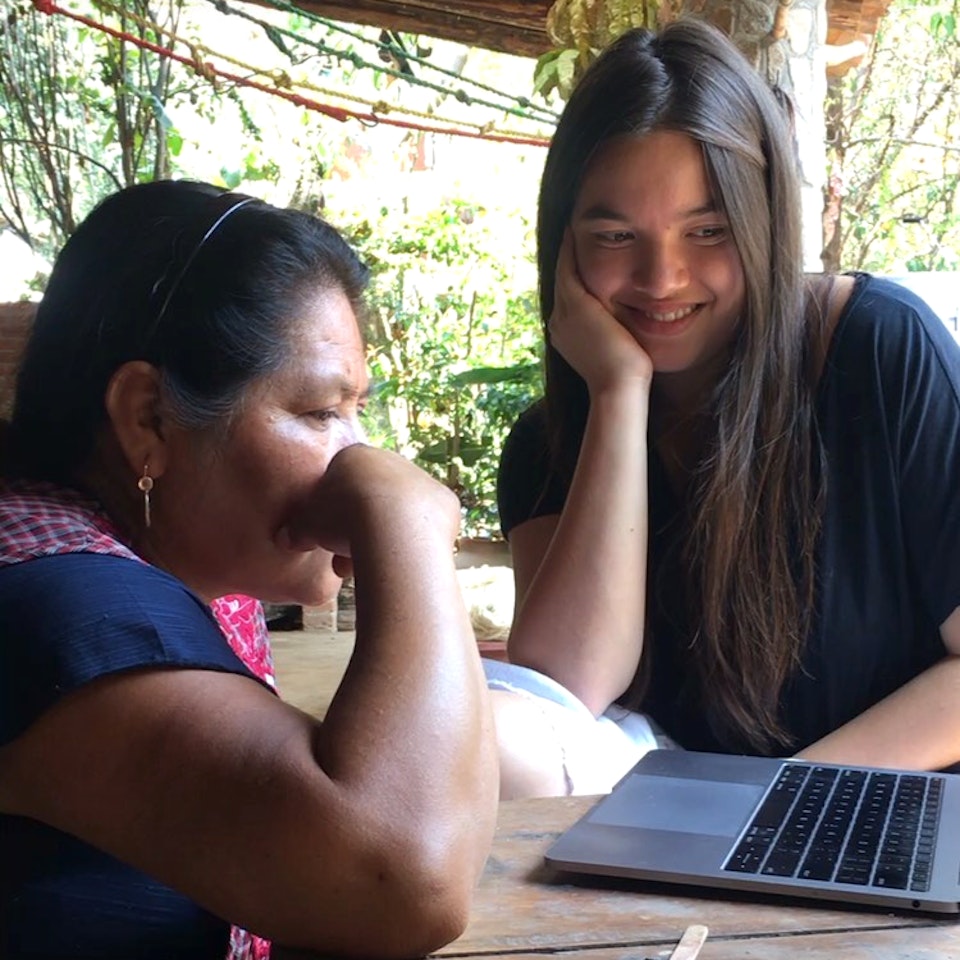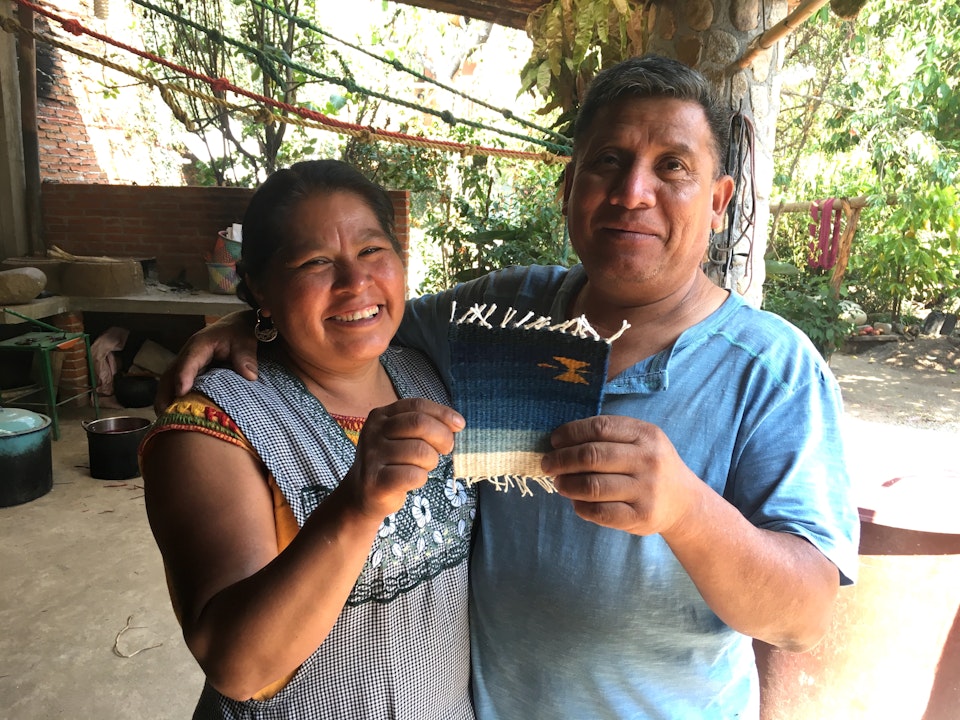July 15, 2019
A Trip to Oaxaca Learning about the Zapotec Weaving and Textile Community in Teotitlán del Valle
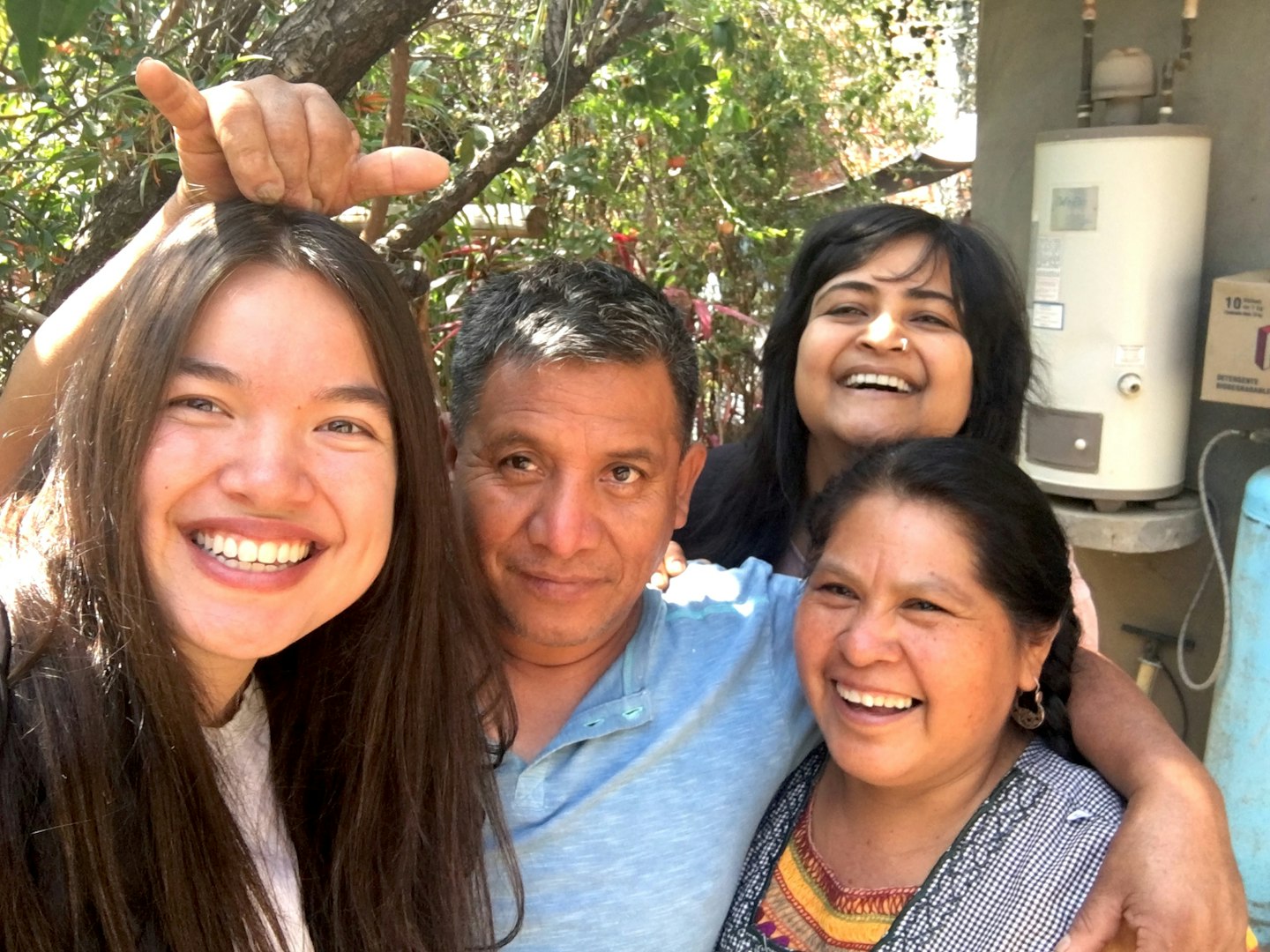
Recently, Team VAWAA lived and worked from Mexico City for a month. Geetika and I were lucky enough to discover just a few glimpses of Mexico’s rich artisanal history. Our most exciting trip, of course, was learning from VAWAA artist Juana and her family in Oaxaca, one of the most respected Zapotec weaving and textile families in Mexico.
About Oaxaca and the Artisan Village of Teotitlán del Valle
Tell anyone who has been to Oaxaca that you’re headed there, odds are their eyes will widen, followed by two hands placed on the heart and a sudden “Aw, I LOVE Oaxaca!” Seriously. Try finding a single soul that isn’t totally smitten by Oaxaca, you won’t.
The entire state of Oaxaca truly is special. Deeply rooted in indigenous traditions, it is home to Mexico’s most thriving arts and crafts scene. It’s also appreciated for its diverse natural landscapes, shaped by mountains and ocean.
The city of Oaxaca itself is recognized by UNESCO as a World Heritage Site and considered one of the culinary capitals of Mexico— most appreciated for its mole, chapulines (grasshoppers) and, of course, mezcal. Gorgeous baroque churches and plazas, vibrantly colorful buildings, cobblestone streets, art galleries with delicate works of master ceramists, painters, printmakers and fashion designers at every street corner… Oaxaca City is a true wonderland and a must-see.
Church of Santo Domingo de Guzmán, Oaxaca City. Courtesy of VAWAA.
While Geetika and I were certainly excited to explore this city, our trip was inspired by a tiny village about 40 minutes east: Teotitlán del Valle. Teotitlán is one of Oaxaca’s dozens of artisan villages, which specializes in a special craft. Famous for its textile history that traces back thousands of years, most families living in Teotitlán are master weavers.
About Juana + Family
We’re incredibly lucky that Juana’s family is among VAWAA’s artist community, offering 6 days learning Natural Dyeing and Indigenous Weaving. They are award-winning masters and one of the most respected Zapotec textile families in the country. They’re leading a push to preserve and reclaim lost indigenous traditions.
As one of twelve families left in the village who still create and use natural dyes, they take much pride and responsibility over their sustainable practices. Other weaving families have turned to synthetic and chemical dyes, succumbing to mass market demand for cheaper and faster production; in most cases, it means they have completely lost the knowledge of working with natural dyes.
We spent an enriching time with Juana, her husband Antonio, and one of their sons Javier, all of whom are textile “maestros”. Vamonos!
The Mini Apprenticeship Experience
It’s about 10:30PM when we touchdown in Oaxaca on a late Friday night (just an hour flight south of Mexico City). Federico, a friend of Juana’s family and taxi driver from Teotitlán, greets Geetika and me at the airport. Knowing that he picks up all VAWAA guests heading for their studio sessions with Juana makes me smile.
We’re exhausted from the week and excited to disconnect from our screens. More importantly, we’re psyched to see Juana and do a VAWAA studio session ourselves!!
My Spanish is a little rusty but I manage to make a full conversation with Federico. As we make our way to the village, Geetika starts seeing familiarity between Oaxaca and the city she grew up in India - from the warm summer breeze to the gorgeous poinciana trees along the dusty streets.
Once we enter the village, there aren’t many lights, so quite frankly we can’t see much. I can feel the anticipation building in my stomach. Finally, we get to the blue gate of their house and Antonio opens the door. The car lights are shining bright in his face so he is squinting and has no idea how ecstatic Geetika and I are to meet and hug him.
As Federico maneuvers into their little courtyard, we spot Juana coming out of their bedroom. She’s wearing a traditional dress under her embroidered apron and two long braids (can confirm she is just as adorable as in her VAWAA photos!).
Master Natural Dyer Juana. Courtesy of Javier Gutierrez.
They lead us into their guest house where we drop our bags. It’s almost midnight at this point, and Juana insists on making hot chocolate for us. Geetika and I look at each other with a smirk— the two of us basically have this unspoken rule when it comes down to chocolate: NEVER say no.
As we sit in the small kitchen and watch Juana stir the pot of chocolate (much less sugary than expected, by the way), we make plans to accompany Juana at the morning market in the village center. We’re pretty worn out, and within a couple of minutes, all of us are in bed.
The joy of getting to experience different cultures
It’s barely 7:30AM when we are woken up by a loud banging noise; we find out it’s Antonio weaving on a big floor loom just upstairs from us. Mexican radio is playing— on full blast of course— and it honestly feels like we’re on set for an authentic Mexican movie scene.
Juana’s waiting for us in the backyard. As we make our way down to the village center, she tells me they have a relative’s birthday party in the afternoon, so she wants to show us around her studio before then.
Walking to the daily morning market. Courtesy of VAWAA.
As Juana shops her ingredients (mostly local and organic), Geetika and I go explore the ins and outs of the market. We’re the only non locals. We’re crazy about mangoes and manage to only buy 9 (don’t worry, they all pretty much fit in the palm of our hand).
There’s also this heavenly cheese-filled green pepper wrapped in an omelette that we gobble up right on the spot, before we even have time to snap a photo. We find Juana carefully picking up a bouquet of flowers for the birthday party.
Gorgeous views and people watching at the market. Courtesy of VAWAA.
Once done shopping, we head back to the house. Seeing Juana’s home in the daylight feels quite surreal. There’s more green than anything; flower pots all around the courtyard, even pomegranate and citrus trees growing at the center. Antonio’s still weaving in the upstairs studio— lively music still going strong. The environment feels fresh and tranquil. I’m feeling so at peace.
The family's courtyard. Courtesy of VAWAA.
As Juana prepares breakfast in the kitchen, Antonio waves us over. We take the stairs up to the open air studio, only to discover a gorgeous view of the lush green mountains surrounding us… I mean WOW.
Views from Juana's home! Courtesy of VAWAA.
I turn my attention back to Antonio, and see the most beautiful wool weavings I’ve ever seen. There’s about five gigantic floor looms and each has a “tapete de lana” (wool weaving) in progress— all with bold, vibrant colors and patterns.
Master weaver Antonio working on his latest pieces. Courtesy of Javier Gutierrez.
I’m seeing Geetika as a child for the first time. The joy on her face is absolutely priceless as she tries weaving again after decades, bringing herself back to her college days in India. She’s a little rusty, so Antonio reminds her of the basics, like creating a little ”montaña” each time she passes the shuttle.
We’re called for breakfast and finally meet Javier, the youngest of three children. He’s in his young 20’s and has also been weaving since he can remember. He works in the family business full-time and serves as Porfirio’s right hand man, managing the day-to-day studio operations and thinking up new designs.
(Porfirio is Juana’s brother and his role as the ambassador of the family is crucial in getting the word out into the world about the family’s work and Zapotec textiles traditions. He spends much of his time in the U.S. educating communities, artists, and educational institutions about the work they’re doing in Teotitlán.)
Learning through experience
Once we’re done eating, Juana takes us into her dyeing studio. It’s also open air and seeing the wool hanging all around the studio and continuing into the backyard among all their plants is simply gorgeous. She gives us a fascinating overview of her work and philosophy.
Colorful wool hanging around the studio. Courtesy of Javier Gutierrez.
Like most people in Teotitlán, both Juana and Antonio have been weaving since early childhood, taught by their parents and inherited from Zapotec civilization. Understanding their role as weavers and natural dyers in respect to the environment is essential; Juana has developed a profound connection with nature, learning to live in synchrony with it, not against.
Today, the family continues to work only with natural dyes and fibers no matter how strenuous the work may be.
They grow them locally as much as possible and work with local growers to grow crops more sustainability, like the indigenous strain of indigo. Juana also creates dyes using the pomegranate and citrus trees from their backyard, as well as other local trees, mosses and barks. Giving a prayer to thank and honor nature before she cultivates any crops remains an important part of her natural dyeing ritual.
“The labor is intensive, costly, and timely, making this artwork rare.”
Creating colors from nature is about chemistry, alchemy, and expertise. Above all, it requires a lifetime of research and experiments.
The natural dyeing process itself is extremely demanding and can take up to three weeks—from collecting the plant, dehydrating it, preparing the yarn, preparing the dye, dyeing the yarn, and finally washing it. (Not to mention the the 5-6 months it takes for wild plants to be ready for harvest.)
The labor is intensive, costly, and timely, making this artwork rare.
Master Juana in her studio. Courtesy of Javier Gutierrez.
What’s even more rare is the number of natural colors Juana has created throughout her years of experimenting. While there are only four or five natural dye colors most commonly used, Juana has created over 300 unique colors! She has documented over 200 of them, so her knowledge can live on, and the family can continue her work and research once she passes. She knows she has a special gift for natural dyeing and thanks God for it.
While she is also a master weaver, creating natural colors and dyeing yarn remains her main passion and focus today. In fact, she provides dyed yarn for the entire family, whether it’s siblings, children, aunts, uncles, nieces, nephews— all are involved in one way or another and it truly is a family business!
She goes on to show us how to make the glorious red color. One word: cochineal. Cochineal is a sessile parasite or insect that lives on cacti (in the genus Opuntia, also known as prickly pear) and feeds on plant moisture and nutrients.
Cochineal growing on cacti. Courtesy of VAWAA.
Juana has actual cochineal growing on “nopal” in her studio. It’s primarily to show guests and curious travelers when they come to visit. In fact, thanks to Porfirio’s relentless efforts to share and preserve Zapotec textile traditions with the world, the family’s work has been featured in the New York Times, the Smithsonian Institution, and the Peabody Museum at Harvard University.
Back to cochineal— once the bug is collected, it is dried up, ready to be sold to natural dyers like Juana.
Dried up cochineal, ready to be crushed. Courtesy of VAWAA.
The next step is to crush the dried insects with a metate. I get a bit of practice in myself and quickly realize how physical it can get; is is quite an art in and of itself…
Crushing the dried insects with a metate under Juana's guidance. Courtesy of VAWAA.
Once I manage to create a small pile of crushed cochineal, Juana gestures me to open up my hand; she puts some in my palm and tells me to wait as she walks off. She comes back with a slice of lime, looks at me to make sure I’m still paying attention, and squeezes the juice into my hand, using her finger to mix the two. The shade of red immediately changes to a purple. What a science!
To think this is just one of dozens of ways Juana creates her desired colors...
Squeezing lime onto crushed cochineal to create color. Courtesy of VAWAA.
Antonio takes over the explanations, walking us across the backyard and into their family shop. It displays final products made by the entire family— mainly big weavings but there is also a small collection of handmade bags and wallets created by other relatives.
Gorgeous pieces of all sizes are exhibited on the walls, from indigo, red, yellow, plum, wine, forest green… the colors are all there and oh so beautiful! No pictures are allowed for the sake of protecting their designs.
After all this, we’re seriously itching to learn how to weave. It wasn’t part of the original plan but Antonio gladly invites us to create our own “mini tapete.” He takes us back upstairs into the weaving studio and sets up two small looms on a mini chair. Geetika and I spend the next 6 hours just weaving away!
Geetika working on her "mini tapete". Courtesy of VAWAA.
Antonio’s very patient with us and makes it a fun learning environment, always cracking jokes but also staying attentive to our weaving. Our designs are quite simple and require minimal color switching, so we’re getting the hang of it pretty quickly.
Antonio excuses himself as he needs to get ready for the party. He and Juana come back out all cutely groomed and dressed up. To be honest, part of me wants to be a fly on their shoulder and join them!
Before heading out, Antonio does a final check on progress. I’m working on weaving a yellow butterfly, so he gives me a few pointers. Javier stays around in case we need any help.
Work in progress. Courtesy of VAWAA.
It’s about 7:00PM, so it’s almost dinner time. We’re weaving with just as much joy and curiosity as we did when we started about 5 hours ago, Javier asks if we want to eat dinner.
He takes us on a quiet walk through the village and we stop at a local family-run restaurant. To no surprise, there are “tapetes” hanging up on all the walls. I go for a “tlayuda” — basically a giant tortilla topped with bean and cheese. I ask if they can add mushrooms because, well, Mexican mushrooms are pretty damn amazing.
Javier and I stopping by Church of the Precious Blood of Christ. Courtesy of VAWAA.
After a simple and tasty dinner, we stop by the church and head back to the house. It’s dark by now but I’m craving to continue my weaving, so I turn the studio lights on and head straight for my loom. Javier’s sorting out photos of various designs besides me— I’m intrigued and ask what he’s up to.
"Each of his designs reinterprets what these fibers and dyes mean as cultural materials, often times representing the evolution of Zapotec culture."
This opens up a beautiful conversation that takes us well into the night, going deep into his passion for Zapotec culture and how he comes up with new designs and concepts for the family’s new pieces. His inspiration ranges from maps to cultural events to Zapotec symbols to his village’s history and even his own photographs of the surroundings.
He shares three of his recent design ideas with me as Geetika joins the conversation. Each of his designs reinterprets what these fibers and dyes mean as cultural materials, often times representing the evolution of Zapotec culture. While the designs all share these common themes, each piece is clearly distinct from each other, with different uses of colors and techniques.
I’m so impressed by his awareness and even more so by his drive to help the family share Zapotec values and culture through their art.
Taking full advantage of the sunshine while weaving. Courtesy of VAWAA.
We spend the next days falling into the flow of this rhythmic art form. Turns out I weaved my butterfly incorrectly and have to do it over. But how can I get mad or feel even the slightest bit of impatience in such a peaceful environment, with Juana nibbling on pistachios and Antonio balancing in the hammock and telling jokes?
As for Geetika, she’s not quite happy with her design and decides to add some more intricacy and colors. Good thing we have all the time in the world to work at our own pace.
When we’re not weaving, we’re off exploring the nearby artisan villages. Just as Teotitlán is a textile community filled with weaving masters, San Bartolo Coyotepec is an entire village with black pottery masters, while San Martin Tilcajete specializes in the Mexican folk art of “alebrijes” (wooden sculptures of fantastical creatures).
Exploring black ceramic studio in San Bartolo Coyotepec (top). Discovering the art of Alebrijes in San Martin Tilcajete (bottom). Courtesy of VAWAA.
We spend our final day in Oaxaca City, with absolutely zero schedule. Walking the colorful, lively streets, into baroque churches and stumbling onto terraces overlooking gorgeous views of the surrounding mountains…
Parting Thoughts on our Art Apprenticeship
Getting to know Juana, her family, and Zapotec culture, learning about her intricate process for natural dyeing, and making my own mini woven piece were just a few highlights of this enriching trip.
Above all, I have to say it’s the little, shared moments that I appreciated most. It’s seeing Juana surprise Antonio with a magnificent hand-made bouquet on his birthday, followed by cheerful singing; chatting with Javier about how different his life and aspirations are from others his age who grew up in Oaxaca City; balancing in a hammock in the backyard and chatting with Juana at 2:00AM who is curious about the reasons why I am vegetarian; or Federico taking a detour for a surprise visit to Santa Maria del Tule, where lives the biggest tree in Oaxaca (it’s 2000 years old!).
Non-stop smiling with Juana and Antonio! Courtesy of VAWAA.
Geetika and I got to experience the rich cultural traditions of the indigenous Zapotec people, and we wish for you, dear reader, to do the same. Gracias for your hospitality and knowledge Juana, Antonio, Javier, Federico, and family!
Want to take unique art lessons like this the next time you book a vacation?
Juana's VAWAA experience is no longer available, but don't worry! You can still learn traditional Zapotec dyeing and weaving outside Oaxaca with Jacobo & Maria.
__
Written by Jenny Quénard.
For more stories and new artist updates, subscribe here.
